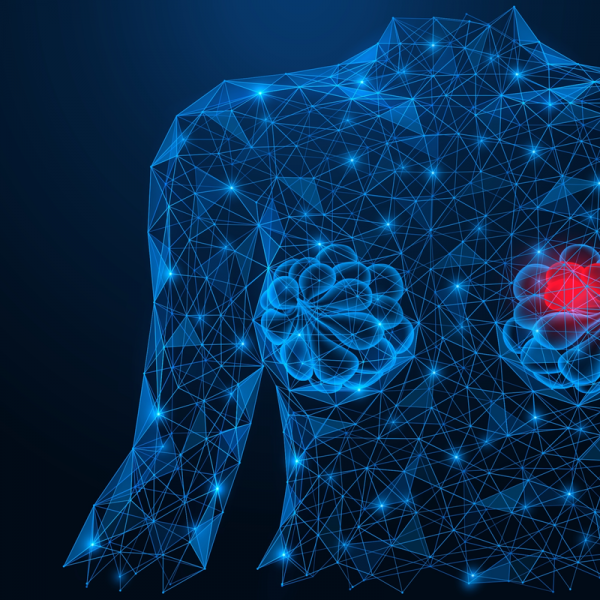
What is a benign breast tumour?
A benign breast tumour is a tumour of the mammary gland that can occur in both women and men. Mammary tumours are often also called mammary gland tumours or breast tumours. Most of these are fibroadenomas or fibrocystic changes. Women are affected by mammary tumours more often than men.
How does a breast tumour develop?
As a fibrocystic change, the mammary tumour develops in the glandular and ductal epithelium. Its growth is mainly triggered by the changing hormonal influences in the female cycle. Cysts of a few millimetres to several centimetres in size can develop from the dilated milk ducts and glandular lobules, the so-called lobules. Although most palpable breast lumps are cysts, the cyst wall also consists of atrophied glandular epithelium. It is extremely rare for this atrophied glandular epithelium to degenerate, which is why cysts hardly ever pose a risk for the development of breast cancer.
What are the causes of the development of a mammary tumour in men?
If a mammary tumour develops in a man, it is often due to a genetic predisposition. This can either be due to mutations that occur spontaneously or are inherited. In particular, mutations of the BRCA1 and BRCA2 genes increase the risk of breast cancer, but also the risk of developing other forms of cancer such as pancreatic, prostate and/or bowel cancer. Furthermore, Klinefelter's syndrome can lead to a congenital disorder in the number of chromosomes. In this case, men have one or more additional female X chromosomes, which inevitably increases the risk of breast cancer.
What are the different types of benign breast tumours?
Benign breast tumours are commonly divided into fibroadenomas and milk duct papillomas. Fibroadenomas are among the most common benign tumours in the breast and form through the proliferation of glandular and connective tissue. If there is a proliferation of glandular tissue, doctors call it an adenoma. In the case of so-called fibromas, on the other hand, there is an excess of connective tissue. Both fibroadenomas and adenomas pose an increased risk of breast cancer.
A papilloma of the milk duct (intraductal papilloma), on the other hand, is a benign growth that affects the inner skin of the milk duct. The milk duct papilloma is usually located in the large milk ducts, which are close to the nipple. However, it can also be located in the smaller milk ducts. It is possible for milk duct papillomas to occur singly or in multiples. Milky duct papillomas form more often than average during the menopause.
What are the symptoms of fibroadenomas and papillomas of the milk duct?
In very few cases does a fibroadenoma cause symptoms. However, before the onset of menstruation, there may occasionally be a feeling of tightness in the affected breast. This pain can easily be mistaken for premenstrual syndrome. A fibroadenoma can be palpated as a smooth-bordered and movable lump, which can sometimes also be somewhat bumpy. The lump can range in diameter from 5 mm to 5 cm.
A milk duct papilloma, on the other hand, can cause a bloody discharge from the nipples.
How is a breast tumour diagnosed?
A breast tumour is diagnosed by a doctor's palpation examination and the usual imaging procedures of a sonography (ultrasound examination) and a mammography (X-ray examination). To rule out a malignant breast tumour, the gynaecologist will in most cases also take a tissue sample (biopsy) and have it examined in the laboratory. A biopsy is particularly advisable if the tumour is growing.
If it is a mammary duct papilloma, the secretion that comes out of the nipple is examined under the microscope for blood and degenerate cells. In addition to the imaging procedures of a sonography and a mammography, a mammoscopy is also performed. The latter is used to determine the extent and exact location of the tumour. During a milk ductoscopy, a so-called galactography, a contrast medium is injected into the milk ducts under local anaesthesia and an X-ray is taken. Based on all these examination results, the doctor finally decides whether the breast tumour needs to be surgically removed or not. In the case that more intraductal papillomas have formed, whose cells also show a certain degree of alteration, the risk is increased that the milk duct papilloma will develop into a malignant type of cancer.
How is a breast tumour treated?
Because mammary tumours are usually harmless, they often do not need to be removed. However, they do need to be checked regularly. This should be done on the one hand by palpating the breast and on the other hand by ultrasound examinations by the gynaecologist treating the patient. The latter ultrasound examinations should be carried out at intervals of three months. Although a benign breast tumour is not cancerous, in many cases it tends to grow further. This can displace the surrounding tissue. Depending on where the breast tumour is located and what size it has grown to, it is also possible to remove the tumour. This can be done with a small operation called a vacuum suction biopsy. The breast tumour is removed either under local anaesthetic or under general anaesthetic. The following reasons could speak in favour of surgical removal of the mammary tumour:
- The affected person perceives the mammary tumour as debilitating or suffers from discomfort.
- The breast tumour is growing rapidly.
- There is an increased risk of breast cancer because the tumour could degenerate.
What is the follow-up care for a breast tumour?
People who have been diagnosed with a breast tumour should talk to their doctor about the intervals at which they need to have a check-up. The same applies after surgical removal of the mammary tumour, as some forms of the disease start to grow more and form again afterwards. This can also be associated with an increased risk of developing a malignant tumour.
